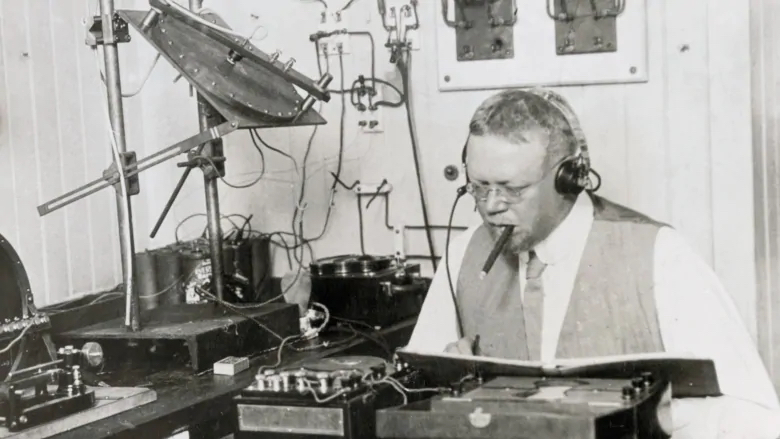Reginald Fessenden is a largely forgotten figure in the history of radio. Not necessarily on the Outer Banks where some of his most noteworthy experiments took place, but overall, the name Fessenden is not as recognized as Marconi who was his contemporary.
Kind of unfortunate because factually he probably had more to do with creating how we think about and use modern radio signals than did Marconi.
Born in what is now Quebec Province, Canada in 1866, Fessenden did most of his work in the United States. He had a wide-ranging intellect and there are some 500 patents listed in his name.
He invented the predecessor to sonar. Its first use was to detect icebergs and undersea obstacles, but in WWI ships were fitted with it to avoid submarines.

Early in his career, working with Edison, he invented an inexpensive filament for lightbulbs, an important step in creating a mass market for electricity. He worked extensively in the science of nautical communications. Toward the end of his life, in 1932, he was experimenting with television signals.
But mostly what he is known for is his use of amplitude modification for voice transmission…what we now call AM.
For a world in transition to the speed and energy of the industrial revolution, Morse Code was the internet of its day when it came to transmitting information. There were, however, problems with it.
Two problems, in particular, were vexing the United States Weather Bureau in 1900. Morse Code was a one-way transmission. A message is sent; it’s decoded and a return message goes back. It was an improvement over any other form of communication of the day, but hardly ideal.
Perhaps more significantly, Morse Code signals had to be carried over a wire. In fact, Marconi’s experiments were in wireless transmission, but two-way conversations were not possible and his early experiments showed the possibility of wireless Morse Code, but only at certain times of the day.
For the Weather Bureau, laying down the wire for the express purpose of carrying Morse Code at remote cites—as an example, Buxton, North Carolina—was cost-prohibitive. No one would partner with them to create the line because the population was so small the only user would be the weather station.
That and the one-way nature of Morse Code and a growing belief that ships at sea should be able to receive weather updates convinced Bureau Chief Willis Moore that an alternative was needed. Fessenden’s experiments in voice transmission over Morse Code were promising and the Bureau made him an offer.
It was a generous offer—$3000 per year, around $91,000 in modern dollars, and Fessenden went to work.
In 1900 he sent a brief and somewhat audible voice message from his Cobb Island, Maryland lab that traveled about one mile through the air.
Encouraged by that he began thinking about how he could transmit over longer distances and more clearly. Feeling he needed an open area where he could set up two transmission towers, he moved his family to Manteo and for the next year and a half immersed himself in his work.
According to a history of the Hatteras Weather Bureau Station, written by National Park Historian Douglas Stover, Fessenden was probably aware of the experiments two bicycle mechanics from Dayton Ohio were doing on the Outer Banks at the time.
“The area was so very remote, you were likely to know your neighbors and while Fessenden was in Manteo, he became close lifetime friends with two other entrepreneurs who were inventors as well. The Wright brothers, Orville and Wilbur, were experimenting with gliders in nearby Kill Devil Hills in preparation for their powered flight experiments,” he wrote.
But it was wireless transmission that fascinated him and for the next year and a half, he dove into his work, moving at one point to Buxton where the weather station was then located.
In March of 1902, he successfully transmitted a 127-word message between Buxton and Manteo over the air, a distance of almost 50 miles.
What he had accomplished was remarkable for its time, so remarkable that the Weather Bureau wanted his patent for the process.
It does get a bit murky here. Fessenden accused Moore and the Weather Bureau of trying to steal his patent, claiming Moore attempted to gain a 50% interest in his patent.
In August of 1902, he resigned from his position with the Weather Bureau.
Over the years, Fessenden was involved in a number of legal battles over patent infringement, most, it would appear he won. He was living in Bermuda when he passed away in 1932.
Although he spent very little time in North Carolina, many of his papers are housed in the State Archives of North Carolina.
